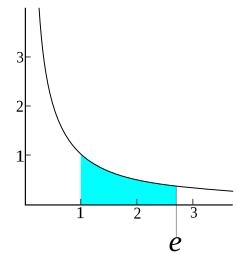
Back E (wiskunde) Afrikaans ኦይለር ቁጥር Amharic Numero e AN ه (رياضيات) Arabic Númberu e AST E (ədəd) Azerbaijani Е (һан) Bashkir E (лік) Byelorussian Неперово число Bulgarian অয়লারের ধ্রুবক Bengali/Bangla
| Euler's number | |
|---|---|
| e 2.71828...[1] | |
| General information | |
| Type | Transcendental |
| History | |
| Discovered | 1685 |
| By | Jacob Bernoulli |
| First mention | Quæstiones nonnullæ de usuris, cum solutione problematis de sorte alearum, propositi in Ephem. Gall. A. 1685 |
| Named after | |

| Part of a series of articles on the |
| mathematical constant e |
|---|
 |
| Properties |
| Applications |
| Defining e |
| People |
| Related topics |
The number e is a mathematical constant approximately equal to 2.71828 that can be characterized in many ways. It is the base of the natural logarithm function. It is the limit of as n tends to infinity, an expression that arises in the computation of compound interest. It is the value at 1 of the (natural) exponential function, commonly denoted It is also the sum of the infinite series
The number e is sometimes called Euler's number, after the Swiss mathematician Leonhard Euler, though this can invite confusion with Euler numbers, or with Euler's constant, a different constant typically denoted . Alternatively, e can be called Napier's constant after John Napier.[2][3] The constant was discovered by the Swiss mathematician Jacob Bernoulli while studying compound interest.[4][5]
The number e is of great importance in mathematics,[6] alongside 0, 1, π, and i. All five appear in one formulation of Euler's identity and play important and recurring roles across mathematics.[7][8] Like the constant π, e is irrational, meaning that it cannot be represented as a ratio of integers, and moreover it is transcendental, meaning that it is not a root of any non-zero polynomial with rational coefficients.[3] To 40 decimal places, the value of e is:[1]
- ^ a b Sloane, N. J. A. (ed.). "Sequence A001113 (Decimal expansion of e)". The On-Line Encyclopedia of Integer Sequences. OEIS Foundation.
- ^ Cite error: The named reference
Millerwas invoked but never defined (see the help page). - ^ a b Weisstein, Eric W. "e". mathworld.wolfram.com. Retrieved 2020-08-10.
- ^ Pickover, Clifford A. (2009). The Math Book: From Pythagoras to the 57th Dimension, 250 Milestones in the History of Mathematics (illustrated ed.). Sterling Publishing Company. p. 166. ISBN 978-1-4027-5796-9. Extract of page 166
- ^ O'Connor, John J.; Robertson, Edmund F. (September 2001). "The number e". MacTutor History of Mathematics Archive. University of St Andrews.
- ^ Sawyer, W. W. (1961). Mathematician's Delight. Penguin. p. 155.
- ^ Wilson, Robinn (2018). Euler's Pioneering Equation: The most beautiful theorem in mathematics (illustrated ed.). Oxford University Press. p. (preface). ISBN 978-0-19-251405-9.
- ^ Posamentier, Alfred S.; Lehmann, Ingmar (2004). Pi: A Biography of the World's Most Mysterious Number (illustrated ed.). Prometheus Books. p. 68. ISBN 978-1-59102-200-8.
© MMXXIII Rich X Search. We shall prevail. All rights reserved. Rich X Search




